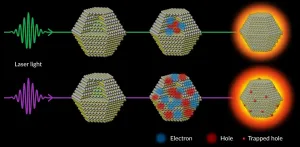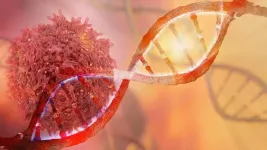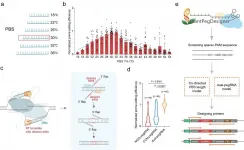(Press-News.org) Bright semiconductor nanocrystals known as quantum dots give QLED TV screens their vibrant colors. But attempts to increase the intensity of that light generate heat instead, reducing the dots' light-producing efficiency.
A new study explains why, and the results have broad implications for developing future quantum and photonics technologies where light replaces electrons in computers and fluids in refrigerators, for example.
In a QLED TV screen, dots absorb blue light and turn it into green or red. At the low energies where TV screens operate, this conversion of light from one color to another is virtually 100% efficient. But at the higher excitation energies required for brighter screens and other technologies, the efficiency drops off sharply. Researchers had theories about why this happens, but no one had ever observed it at the atomic scale until now.
To find out more, scientists at the Department of Energy's SLAC National Accelerator Laboratory used a high-speed "electron camera" to watch dots turn incoming high-energy laser light into their own glowing light emissions.
The experiments revealed that the incoming high-energy laser light ejects electrons from the dot's atoms, and their corresponding holes - empty spots with positive charges that are free to move around - become trapped at the surface of the dot, producing unwanted waste heat.
In addition, electrons and holes recombine in a way that gives off additional heat energy. This increases the jiggling of the dot's atoms, deforms its crystal structure and wastes even more energy that could have gone into making the dots brighter.
"This represents a key way that energy is sucked out of the system without giving rise to light," said Aaron Lindenberg, a Stanford University associate professor and investigator with the Stanford Institute for Materials and Energy Sciences at SLAC who led the study with postdoctoral researcher Burak Guzelturk.
"Trying to figure out what underlies this process has been the subject of study for decades," he said. "This is the first time we could see what the atoms are actually doing while excited state energy is being lost as heat."
The research team, which included scientists from SLAC, Stanford, the University of California, Berkeley and DOE's Lawrence Berkeley National Laboratory, described the results in Nature Communications today.
Emitting a pure, brilliant glow
Despite their tiny size - they have about the same diameter as four strands of DNA - quantum dot nanocrystals are surprisingly complex and highly engineered. They emit extremely pure light whose color can be tuned by adjusting their size, shape, composition and surface chemistry. The quantum dots used in this study were invented more than two decades ago, and today they're widely used in bright, energy-efficient displays and in imaging tools for biology and medicine.
Understanding and fixing problems that stand in the way of making dots more efficient at higher energies is a very hot field of research right now, said Guzelturk, who carried out experiments at SLAC with postdoctoral researcher Ben Cotts.
Previous studies had focused on how the dots' electrons behaved. But in this study, the team was able to see the movements of whole atoms, too, with an electron camera known as MeV-UED. It hits samples with short pulses of electrons with very high energies, measured in millions of electronvolts (MeV). In a process called ultrafast electron diffraction (UED), the electrons scatter off the sample and into detectors, creating patterns that reveal what both electrons and atoms are doing.
As the SLAC/Stanford team measured the behavior of quantum dots that had been hit with various wavelengths and intensities of laser light, UC Berkeley graduate students Dipti Jasrasaria and John Philbin worked with Berkeley theoretical chemist Eran Rabani to calculate and understand the resulting interplay of electronic and atomic motions from a theoretical standpoint.
"We met with the experimenters quite often," Rabani said. "They came with a problem and we started to work together to understand it. Thoughts were going back and forth, but it was all seeded from the experiments, which were a big breakthrough in being able to measure what happens to the quantum dots' atomic lattice when it's intensely excited."
A future of light-based technology
The study was carried out by researchers in a DOE Energy Frontier Research Center, Photonics at Thermodynamic Limits, led by Jennifer Dionne, a Stanford associate professor of materials science and engineering and senior associate vice provost of research platforms/shared facilities. Her research group worked with Lindenberg's group to help develop the experimental technique for probing the nanocrystals.
The center's ultimate goal, Dionne said, is to demonstrate photonic processes, such as light absorption and emission, at the limits of what thermodynamics allows. This could bring about technologies like refrigeration, heating, cooling and energy storage - as well as quantum computers and new engines for space exploration - powered entirely by light.
"To create photonic thermodynamic cycles, you need to precisely control how light, heat, atoms, and electrons interact in materials," Dionne said. "This work is exciting because it provides an unprecedented lens on the electronic and thermal processes that limit the light emission efficiency. The particles studied already have record quantum yields, but now there is a path toward designing almost-perfect optical materials." Such high light emission efficiencies could open a host of big futuristic applications, all driven by tiny dots probed with ultrafast electrons.
INFORMATION:
This work is part of the Photonics at Thermodynamic Limits Energy Frontier Research Center, funded by the DOE Office of Science. MeV-UED is operated as part of SLAC's Linac Coherent Light Source, a DOE Office of Science user facility. Parts of the work were performed at the Center for Nanoscale Materials, a DOE Office of Science user facility at Argonne National Laboratory, and at the Stanford Nano Shared Facilities.
SLAC is a vibrant multiprogram laboratory that explores how the universe works at the biggest, smallest and fastest scales and invents powerful tools used by scientists around the globe. With research spanning particle physics, astrophysics and cosmology, materials, chemistry, bio- and energy sciences and scientific computing, we help solve real-world problems and advance the interests of the nation.
SLAC is operated by Stanford University for the U.S. Department of Energy's Office of Science. The Office of Science is the single largest supporter of basic research in the physical sciences in the United States and is working to address some of the most pressing challenges of our time.
In the year since the coronavirus pandemic upended how just about every person on the planet interacts with one another, video conferencing has become the de facto tool for group collaboration within many organizations. The prevalent assumption is that technology that helps to mimic face-to-face interactions via a video camera will be most effective in achieving the same results, yet there's little data to actually back up this presumption. Now, a new study challenges this assumption and suggests that non-visual communication methods that better synchronize and boost audio cues are in fact more effective.
Synchrony Promotes Collective Intelligence
Researchers from Carnegie Mellon's Tepper School of Business and the Department of Communication at the University of California, Santa ...
Despite having remarkable utility in treating movement disorders such as Parkinson's disease, deep brain stimulation (DBS) has confounded researchers, with a general lack of understanding of why it works at some frequencies and does not at others. Now a University of Houston biomedical engineer is presenting evidence in Nature Communications Biology that electrical stimulation of the brain at higher frequencies (>100Hz) induces resonating waveforms which can successfully recalibrate dysfunctional circuits causing movement symptoms.
"We investigated the modulations in local ?eld potentials induced by electrical stimulation of the subthalamic nucleus (STN) at therapeutic and non-therapeutic frequencies in Parkinson's disease patients ...
LA JOLLA--The glow of a panther's eyes in the darkness. The zig-zagging of a shark's dorsal fin above the water.
Humans are always scanning the world for threats. We want the chance to react, to move, to call for help, before danger strikes. Our cells do the same thing.
The innate immune system is the body's early alert system. It scans cells constantly for signs that a pathogen or dangerous mutation could cause disease. And what does it like to look for? Misplaced genetic material.
The building blocks of DNA, called nucleic acids, are supposed to be hidden away in the cell nucleus. Diseases can change that. Viruses churn out genetic material in parts of the cell where it's not supposed to be. Cancer cells do too.
"Cancer cells harbor damaged DNA," says ...
New clues to a long-pursued drug target in cancer may reside within immune cells, researchers at the University of Michigan Rogel Cancer Center have discovered.
The findings, which appear in Nature Immunology, not only shed new light on cancer immunology, they also suggest clinical trials related to this key target -- an interaction that destabilizes the important p53 tumor suppressor protein -- may unnecessarily be excluding a large number of patients.
The researchers are optimistic that the findings could help make immunotherapy treatment more effective against ...
CORVALLIS, Ore. - Warm river habitats appear to play a larger than expected role supporting the survival of cold-water fish, such as salmon and trout, a new Oregon State University-led study published today found.
The research has important implications for fish conservation strategies. A common goal among scientists and policymakers is to identify and prioritize habitat for cold-water fish that remains suitably cool during the summer, especially as the climate warms.
This implicitly devalues areas that are seasonally warm, even if they are suitable for fish most of the year, said Jonny Armstrong, lead author of the paper and an ecologist at Oregon State. He called this a "potentially severe blind spot for climate change adaptation."
"Coldwater ...
Lithium-ion batteries have made possible the lightweight electronic devices whose portability we now take for granted, as well as the rapid expansion of electric vehicle production. But researchers around the world are continuing to push limits to achieve ever-greater energy densities -- the amount of energy that can be stored in a given mass of material -- in order to improve the performance of existing devices and potentially enable new applications such as long-range drones and robots.
One promising approach is the use of metal electrodes in place of the conventional graphite, with a higher charging ...
Many psychiatric disorders have genetic causes, but the exact mechanism of how genes influence higher brain function remains a mystery. A new study provides a map linking the genetic signature of functions across the human brain, a tool that may provide new targets for future treatments.
Led by Bratislav Misic, a researcher at The Neuro (Montreal Neurological Institute-Hospital) of McGill University, a group of scientists performed machine learning analysis of two Open Science datasets: the gene expression atlas from the Allen Human Brain Atlas and the functional ...
DURHAM, N.C. - Engineers at Duke University have developed an electronics-free, entirely soft robot shaped like a dragonfly that can skim across water and react to environmental conditions such as pH, temperature or the presence of oil. The proof-of-principle demonstration could be the precursor to more advanced, autonomous, long-range environmental sentinels for monitoring a wide range of potential telltale signs of problems.
The soft robot is described online March 25 in the journal Advanced Intelligent Systems.
Soft robots are a growing trend in the industry due to their versatility. Soft parts can handle delicate objects such as biological tissues that metal or ceramic components would damage. Soft bodies can help robots float or squeeze into tight spaces where rigid ...
Lincoln, Neb., March 25, 2021 -- Palm oil, the most important source of vegetable oil in the world, is derived from the fruit of perennial palm trees, which are farmed year-round in mostly tropical areas. The palm fruit is harvested manually every 10 days to two weeks, then transported to a mill for processing, and ultimately exported and made into a dizzying array of products from food to toiletries to biodiesel.
"You probably ate palm oil for breakfast," said Patricio Grassini, an associate professor of agronomy at the University of Nebraska-Lincoln. "There is probably palm oil in your ...
Precision genome editing enables the precise modification of DNA in living cells, thus enabling a breadth of opportunities for plant breeding. Prime editors, developed by Prof. David R. Liu and his colleagues, permit the installation of desired edits in a programmable target site. They are comprised of an engineered Cas9 nickase (H840A)-reverse transcriptase (RT) fusion protein and a prime editing guide RNA (pegRNA).
Prime editors were previously developed and optimized as an extremely versatile editing strategy for generating programmable point mutations, insertions and deletions in rice and wheat by Prof. GAO Caixia of the Institute of Genetics and Developmental Biology (IGDB) of the Chinese Academy of Sciences ...






